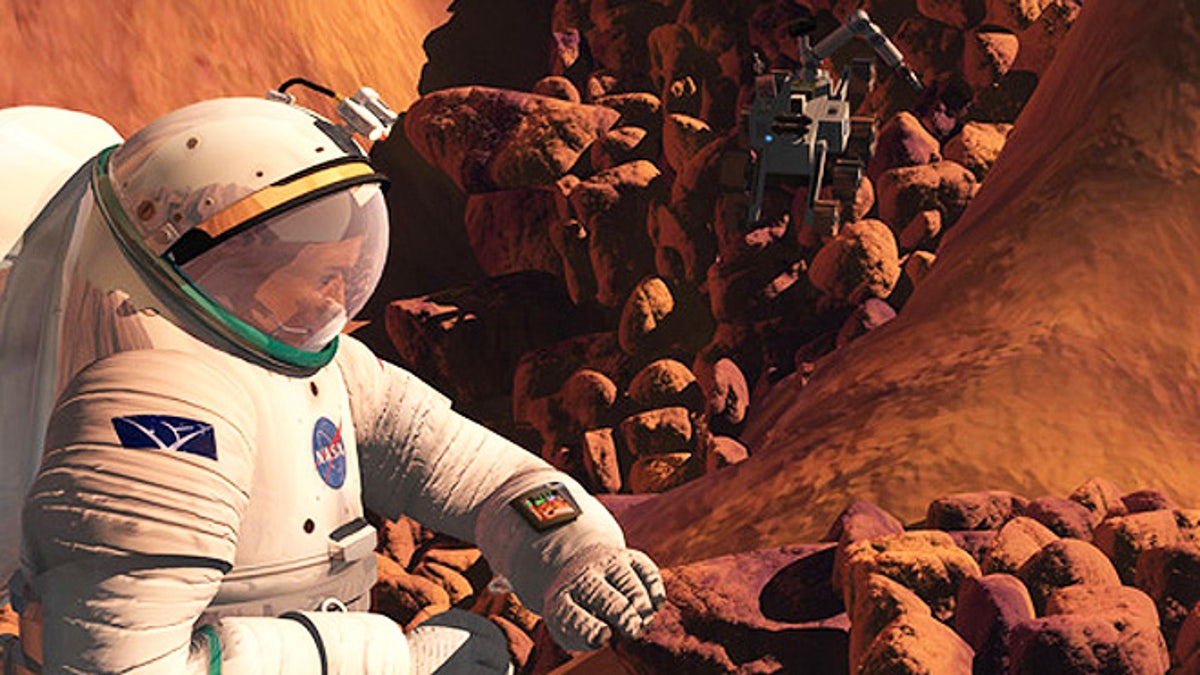
In this artist's concept of the future, an astronaut gathers samples on the surface of Mars, while a robotic explorer stands by to help. (NASA)
We're mere days away from one of the most highly anticipated Martian landings of all time.
At 1:31 a.m. EDT on Monday, Aug. 6, NASA's Mars Science Laboratory rover Curiosity will land in Gale Crater on the fourth planet from the sun. The incredibly sophisticated rover is a mobile laboratory designed to run tests on soil to determine whether or not the Martian environment ever had the conditions to support life.
But in the 1960s, the future of Mars exploration looked very different. In many instances, there were men aboard the spacecraft that were designed to fly by the red planet rather than land on it.
PHOTOS: When Discovery News Met Mars Rover 'Curiosity'
In the 1960s, NASA considered flyby missions almost as often as it did landing missions. The proposals, like some of the more interesting missions to Venus, came from Bellcom, a division of AT&T established in 1963 to assist NASA with research, development and overall documentation of systems integration.
A 1966 Bellcomm proposal cites the weight of a spacecraft bound for Mars as the mission’s limiting factor. That's unsurprising. It takes a lot of fuel to send a spacecraft into orbit, and more to send it to an interplanetary destination.
But the planets can actually lend a hand on these long distance missions. If a spacecraft passes a planet at the right point, its gravity will slingshot the spacecraft away adding momentum to its interplanetary flight. This is how the Voyager spacecraft managed their impressive tours of the outer solar system.
The same gravity assist maneuvers can be equally effective in the inner solar system, and while it might seem counterintuitive, Bellcomm engineers found that a mission to Mars could benefit from flying by Venus on its way to the red planet.
PHOTOS: Seven Minutes of Terror for Mars Rover Curiosity
A September 1967 proposal outlines a possible triple-flyby mission that would send a spacecraft to Venus and Mars. Based on the geometry of the planets -- taking advantage of optimal alignment -- the ideal launch date for this mission was May 26, 1981. The spacecraft would launch towards Venus, reaching the planet on Dec. 28. It would whip around and head for Mars, making its contact on Oct. 5, 1982. The inbound leg of the journey would take it back by Venus on March 1, 1983 before returning to Earth on July 25. The mission would last 790 days.
The launch window for this proposal was 30 days. Launching on another date in the window would change the duration of the mission, making it last anywhere from 720 days to 850 days.
Three-planet flybys were thought to be rare; the 1981 launch window came as a surprise to the Bellcomm engineers. It inspired them to look for similar opportunities and they found that conditions for triple-flybys are actually fairly common.
By October 1967, the company had identified a dual-flyby mission, one that would send a spacecraft to Venus then Mars and back to Earth with the option to revisit Venus on the inbound leg. In this scenario, a launch on Nov. 28, 1978 would take the spacecraft by Venus on May 11, 1979, Mars on Nov. 25, 1979, and Venus again on Jan. 29, 1980 before returning to Earth on Jan. 31, 1981.
HOWSTUFFWORKS: How the Mars Curiosity Rover Works
For possible crews aboard these missions, they would have a long trip likely filled with astronomical observations punctuated by exciting days spent flying by Venus and Mars. Both proposals sent the crew within 1,200 miles of the surface of Venus; in 1970 this would happen on the day side of the planet while the 1980 opportunity would have take them to the planet’s dark side. Of course, infrared sensors and mapping radar would work either way.
For the engineers and NASA, this was a cost efficient way to send men to Mars.
These kinds of proposals would probably never gain any serious traction in NASA’s current climate, especially not for manned missions. The duration alone would likely draw criticism, though it’s not much shorter than the roughly 500-day window most direct missions to Mars are expected to take.
But a swing by Venus could return valuable data, and give the crew not one but two fascinating sights during their mission.




















